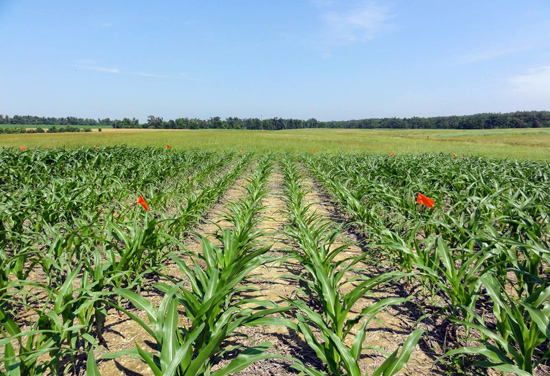Researchers studying if soil amendments can lower fragipan depth
Researchers studying if soil amendments can lower fragipan depth

A fragipan is a cement-like layer found in some soils. Soils containing this layer are common throughout the major crop production areas of Kentucky, and they limit grain crops’ yield potential, especially during dry seasons. University of Kentucky College of Agriculture soil scientist John Grove is conducting a study that will look at potential ways to move the fragipan layer deeper in the soil profile and increase corn and soybean yields.
“Many of the fragipan soils in Kentucky are rated by the Natural Resources Conservation Service as Class II or III soils and only about two-thirds of them are being actively farmed or pastured,” Grove said. “My vision for this study is that we will learn a way to add value to the soil and help growers move their ground to a higher level of productivity.”
About 250,000 acres of Kentucky soybeans are on grown on fragipan soils. The fragipan affects crop yields by causing excessive moisture during wet periods in the spring. This can delay planting or result in compaction caused by “mudding in” a crop. In addition, fragipan soils increase the probability that the plant will experience drought stress during dry periods that are normally experienced during a Kentucky summer. Fragipan restricts plant root growth, and roots cannot reach available water deeper in the soil. In addition, Kentucky’s fragipan subsoils are often acidic, which can further restrict plant root growth and water uptake.
In a study funded by the Kentucky Soybean Promotion Board, Grove and fellow UK soil scientist Edwin Ritchey conducted small-plot research in 2012 to determine if the addition of either gypsum or poultry litter or both could lower the fragipan depth and increase corn and soybean production.
Previous studies in other countries have shown gypsum can reduce the effects of acidic soil on corn crops. In an unrelated study at the UK Research and Education Center in Princeton, researchers made a chance observation that poultry litter might increase the depth of the fragipan in the soil profile.
Grove and Ritchey’s 2012 study occurred on 128 plots (64 plots for each crop) at the UK Research and Education Center at Princeton on a Sadler silt loam with a fragipan. They amended crop-specific plots with 16 replications each of 3 tons of gypsum, 3 tons of poultry litter, both or neither. They will repeat the study during the 2013 growing season.
In the 2012 study, soybean plots that received poultry litter only and plots with poultry litter and gypsum yielded two more bushels per acre than plots without either amendment or only gypsum. Grove noted that because the 2012 drought was so severe, there was not a significant amount of moisture to move the gypsum and/or soluble poultry litter constituents deeper into the soil. When the amendments move deeper in the soil, greater yield returns are expected.
“We know from studies in Brazil and Africa that if you’re going to see any benefit from gypsum, it should appear by the second year,” Grove said. “We’re hoping rain this winter will help move the soluble constituents deeper into the soil so that we can see benefits from gypsum this year.”
If the amendments cause the fragipan to move deeper into the soil, researchers hope to learn if the movement is caused by the fragipan actually dissolving or dissolving and reforming at a deeper depth.
Agricultural Economics Extension Plant & Soil Sciences Research

